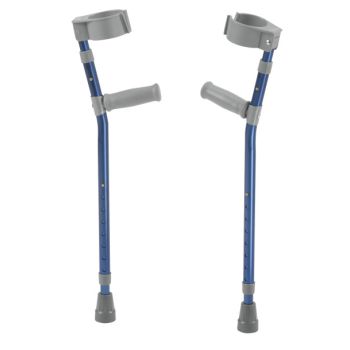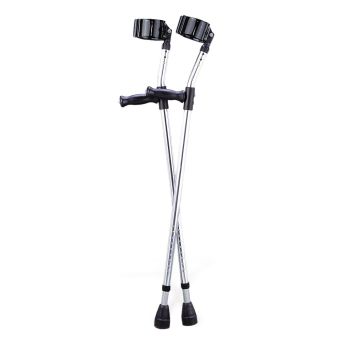Free shipping orders over $50
Pediatric Crutches / Crutches for Kids
Find the best crutches for kids on the market to help your little ones move around and stay busy! Children’s crutches are designed for little arms and little legs. Our child crutches for toddlers and older kids (usually below 13 years of age) can help improve mobility and get your child on crutches to the fast track of recovery or mobility support. Aside from children, shorter adults can also benefit from these smaller crutches. Shop child crutches on AvaCare Medical now! Read More...
-
McKesson Push Button Aluminum Crutches
Starting at $40.36 -
Pediatric Forearm Crutches
Starting at $88.40 -
Guardian Forearm Crutches
Starting at $40.48 -
Underarm Crutches
Starting at $44.15
What Pediatric Crutches Are About
Whether you’re a parent seeking information for your kid on crutches or you’re a shorter adult trying to find crutches that work for your needs, it is important to understand a few specific details that make short crutches unique. Of course, the most notable difference is the base height and adjusted height. The underarm height of pediatric kid size crutches (axillary crutches) is approximately 31”-40” long. Shorter crutches are good for users who are anywhere from 4 to 4 ½ feet tall. Youth crutches are a bit larger and can accommodate users who stand anywhere from 4.5 feet to 5 feet 2 inches tall. There are some models available for taller children that are 6 feet tall and taller – but for these, one may easily consider using adult crutches.
For forearm crutches, there are often multiple sizes available (small, medium, and large). Each size is designed for children of different heights. Some of them (such as those in our inventory) are also available in multiple colors that can be selected before purchasing. Child size crutches with forearm supports are made to help assist children that are anywhere from 2.5 feet up to 3.5 feet tall. Medium kid forearm crutches are available to help an older child on crutches between 3 feet 2 inches and 4 feet 5 inches. Large-sized pediatric crutches can help assist both older kids and young teenagers, and can also be used as petite crutches for short adults between 4.25 feet and 5 feet 5 inches tall.
Weight Capacity
Forearm crutches generally have a lower weight capacity than axillary (armpit) crutches. Actually, weight capacity can depend on whether the child size crutches are meant for younger or older children. Axillary crutches for older kids, taller teenagers and youth can have a weight capacity of up to 350 pounds, while the smaller pediatric models only have a 175 pound weight capacity.
Weight capacity is something to seriously consider when choosing crutches. For example, if a parent has a child who is attending school and weighs 170 pounds, the parent should consider the weight of the student’s books and materials as well. Choosing crutches with an insufficient weight capacity can cause loss of balance and lower mobility, and even can lead to increased wear and tear on the crutches themselves. It could also void the manufacturer’s warranty. One should never compromise safety in any way when choosing crutches for a small child, no matter how old or strong the user may be.
Benefits of Little Kid Crutches
Little kid crutches have many benefits (when used by children or short adults) in comparison to other kinds of crutches. Children with mild to moderate disabilities may benefit from forearm crutches or armpit crutches, while others with more serious conditions may need to use a pediatric walker or even a wheelchair instead. It’s also important that a child be assessed by a doctor to determine whether or not they can use crutches safely. The average age that many physicians will allow a child to use crutches is 7 years old, although some younger kids have been known to use crutches as long as they are cleared by a doctor. However, if pediatric crutches are the best option, they offer many advantages. Some of these are:
Improved Posture and Gait
Children with disabilities or injuries often have problems with their walking gait. While other children may need a different mobility aid (such as a walker, as mentioned above), still others can benefit from using crutches instead. Crutches are designed to help the child’s spine remain straight while the child moves forward appropriately. They can also help kids to improve their walking gait when possible. Some children can further benefit by using crutches in non-weight-bearing situations to improve posture and augment upper body strength.
Mobility Aid for Disabled Children
Some children who suffer from debilitating diseases such as cerebral palsy or various musculoskeletal disorders can benefit from the use of crutches. While many of them sadly only have a certain amount of time before they end up completely wheelchair-bound, these walking aids promote psychological support and independence while they can have it. Many handicapped children want to have as much of a normal life as possible, and pediatric crutches help them to experience walking in a manner that is as similar to other kids as is possible.
Quicker Rate of Recovery
While children are indeed capable of healing faster than most adults, they still may suffer from accidentally bearing weight down on their injured legs if they have a sprain or broken bone. Therefore, pediatric crutches do the same thing that adult crutches do – they help the child keep their weight off of their injured leg when possible. Even in children, the average broken bone takes approximately 4 to 6 weeks to heal fully. It has been medically proven that crutches may even speed up recovery time in children, allowing the sprained or broken bone or tendon to heal within 2-3 weeks.
Disadvantages of Crutches for Kids: Tips for Parents
Children need special guidance from their parents in using crutches. They may have a hard time learning how to use them, but with practice, they can get a hang of it. However, in order for them to learn the ropes, it is extremely important that their living situation is prepared appropriately. Remove obstacles that may cause trips and falls and be sure that hallways and any areas your child will be walking through are as clear as possible, with no tripping hazards. A child who has a leg injury most likely won’t be experienced with managing a mobility aid if their injury is something that they haven’t experienced before.
Another important factor to keep in mind is that during a disability that requires the use of crutches, your child may develop a sudden pattern of incontinence. If that does happen, be sure to speak to your doctor. Often, it is not a case of urge incontinence (the type commonly treated with adult diapers), but rather functional incontinence. This means that it may simply be too hard for your child to get to the bathroom on time because of their disability.
We want to make sure that your little one can get the best set of crutches for kids possible, and therefore, we offer only the best children’s crutches from the top manufacturers in the US. If you have any questions, concerns, or need assistance with your order, dial 1-877-813-7799 to speak with a qualified and professionally trained customer caregiver today!







